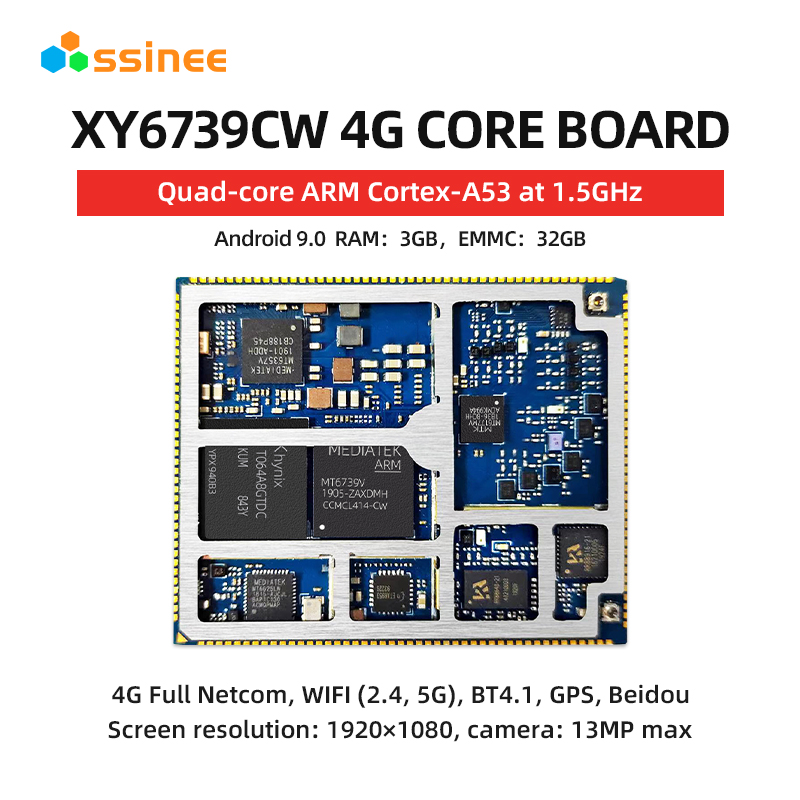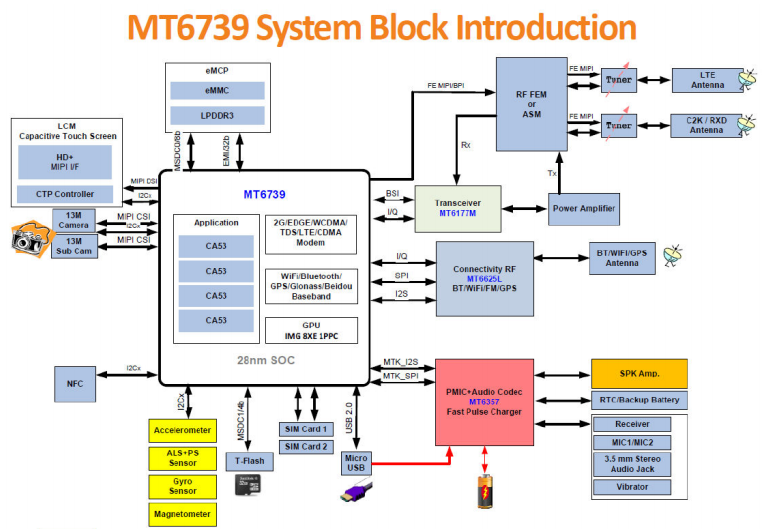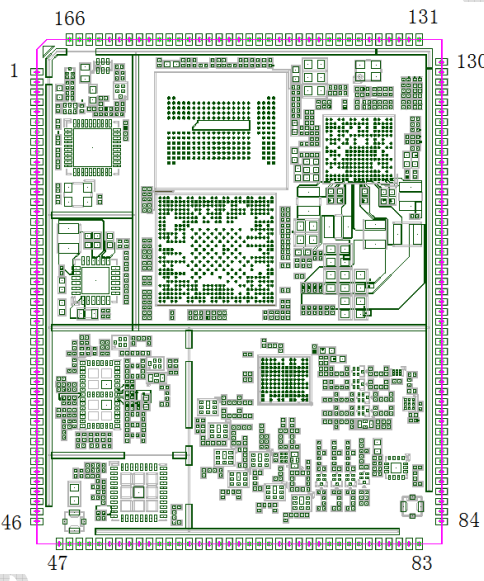
CPU: MediaTek MT6739
Architecture: ARM Cortex-A53 Quad-core 1.5GHz
OS : Andriod 9.0
Memory : 1GB+8GB/2GB+16GB/3GB+32GB
Network support : 2G/3G/4G full network access
Wireless connectivity : WiFi/Bluetooth/GPS/Beidou
Product introduction
XY6739CW is a 4G smart module based on MTK’s MTK6739 platform, industrial grade and high performance, running Android OS, supporting LTE-FDD/LTE-TDD/WCDMA/TD-SCDMA/EVDO/CDMA/GSM and other standards; supporting WiFi 802.11b/g/n, BT4.0LE Near-range wireless communication, support GPS/GLONASS/BeiDou satellite positioning; support a variety of voice and audio codecs, internal integration of IMG 8XE high-performance graphics engine, can smoothly play 1080P video; have multiple audio, video input and output interfaces and rich GPIO interface.
The supported frequency bands are listed below:
| Type | Network band |
| LTE-FDD (with Rx-diversity) | B1/B3/B5/B8/B20 |
| LTE-TDD (with Rx-diversity) | B38/B39/B40/B41 |
| WCDMA | B1/B2/B5/B8 |
| TD-SCDMA | B34/B39 |
| EVDO/CDMA | BC0 |
| GSM | 850/900/1800MHz |
| WiFi 802.11a/b/g/n | 2400-2483.5MHz/5725-5850MHz |
| BT4.0 LE | 2400-2483.5MHz |
| GNSS | GPS+Glonass/Beidou |
Main performance parameters
The following describes the detailed performance parameters of the XY6739
Application processor:
Quad-core ARM Cortex-A53 processor; main frequency up to 1.5 GHz; 256KB Level 2 cache
Modem processor:
MIPS32, ARM up to 600 MHz, 256KB L2
Power supply:
VBAT supply voltage range: 3.5V~4.3V
Typical supply voltage: 4.0V
Transmit Power
Class 4 (33dBm±2dB) for GSM850/GSM900
Class 1 (30dBm±2dB) for DCS1800
Class E2 (27dBm±3dB) for EGSM900/GSM850 8PSK
Class E2 (26dBm±3dB) for DCS1800 8PSK
Class 3 (24dBm+1/-3dB) for WCDMA bands
Class 3 (24dBm+1/-3dB) for CDMA BC0
Class 3 (24dBm+1/-3dB) for TD-SCDMA B34/B39
Class 3 (23dBm ±2.7dB) for LTE FDD bands
Class 3 (23dBm ±2.7dB) for LTE TDD bands
LTE Features:
Supports 3GPP R9 CAT4 FDD and TDD
Supports 1.4 – 20 MHz RF bandwidth
Supports downlink 2 x 2 MIMO
FDD: Max 150Mbps (DL), 50Mbps (UL)
TDD: Max 100Mbps (DL), 40Mbps (UL)
WCDMA features:
Supports 3GPP R9 DC-HSPA+
Support 16-QAM, 64-QAM and QPSK modulation
3GPP R6 HSUPA: Max 11Mbps (UL)
3GPP R8 DC-HSPA+: Max 42Mbps (DL)
TD-SCDMA features:
Support 3GPP R8 1.28 TDD
TD-HSDPA:MAX 2.8Mbps (DL)
TD-HSUPA:MAX 2.2Mbps (UL)
CDMA features: Max 3.1Mbps (DL), 1.8 Mbps (UL)
GSM/GPRS/EDGE features:
GPRS: Support GPRS multi-slot class 12
Coding formats: CS-1, CS-2, CS-3 and CS-4
Maximum 4 Rx time slots per frame
GSM/GPRS/EDGE features:
EDGE:
Supports EDGE multi-slot class 12
GMSK and 8PSK support
Coding formats: CS1-4 and MCS 1-9
WLAN features: 2.4GHz/5GHz dual-band, support 802.11a/b/g/n, up to 150Mbps; support AP mode
Bluetooth features: BT4.0 LE
Satellite positioning: GPS+Glonass/Beidou
Short Message (SMS):
Text and PDU modes
Point-to-point MO and MT
SMS Broadcast
SMS Storage: Default SIM
AT commands not supported
LCM Interface:
4 groups of MIPI_DSI, each supporting up to 1.0Gbps rate;
Supports up to 1440*720 60fps (4 groups of MIPI_DSI);
24bit color depth
Camera interface:
4 groups of MIPI_CSI, each group supports up to 1.5Gbps rate, can support 2 cameras;
Rear camera with 4 groups of MIPI_CSI, supporting up to 13MP pixels
Front camera uses 4 groups of MIPI_CSI, supporting up to 13MP pixels
Front and rear cameras can support dual recording, picture-in-picture function
Audio Interface
Audio input:
3 groups of analog microphone inputs
1 as headset MIC input, the other two are normal call noise reduction MIC
Audio output
Class AB stereo headphone output
Class AB differential earpiece output
Class AB/D differential speaker amplifier output 0.8W
USB interface:
Support USB2.0 high-speed mode, data transfer rate up to 480Mbps
For software debugging and software upgrade, etc.
Support USB OTG (requires additional 5V power supply chip)
USIM card interface:
2 groups of USIM card interface
Support USIM/SIM card: 1.8V and 3V
Support dual card dual standby
SDIO interface: support SD3.0; 4bit SDIO; SD/MMC card; support hot-swappable
I2C interface: 4 groups of I2C, the highest rate up to 400K, when using I2C DMA the highest speed can reach 3.4Mbps, for TP, Camera, Sensor and other peripherals
ADC interface: 1 way, for general purpose ADC
Antenna interface MAIN antenna, DRX antenna, GNSS antenna, WIFI/BT antenna interface
Physical characteristics:
Size: 40.5±0.15×50.5±0.15×2.8±0.2 mm
Interface: LCC
Warpage: <0.3mm<>
<0.3mm<>
Weight: 10.9g
Temperature range:
Normal operating temperature: -20°C ~ +70°C
Extreme operating temperature: -25°C and +80°C 1)
Storage temperature: -40°C ~ +85°C
Software upgrade: via USB
RoHS: RoHS compliant
XY6739 functional block diagram illustrating its main functions:
Power Management
RF section
Baseband section
LPDDR3+EMMC memory
Peripheral Interface
–USB interface
–USIM card interface
–UART interface
–SDIO Interface
–I2C interface
–ADC interface
–LCD (MIPI) interface
–TP interface
–CAM(MIPI) interface
–AUDIO interface

Development Boards
To help test and use the XY6739 module, MobileTech can provide a set of development boards.
Application Interfaces
Overview
The XY6739 has 166 SMT pads with 1.0mm pitch. The following sections detail the functions of the module’s various interface groups:
Power Supply
VRTC Interface
LCM Interface
TP interface
Camera interface
Audio Interface
USB Interface
USIM Interface
UART Interface
SDIO Interface
I2C Interface
ADC interface
XY6739 pin assignment diagram:

